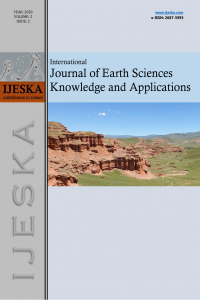Abstract
References
- Artmanna, M., Kohlera, M., Meinela, G., Ganb, J., Iojac, I-C., 2019.How smart growth and green infrastructure can mutually support each other - A conceptual framework for compact and green cities. Ecological Indicators 96 (2), 10-22.
- Beatley, T., 2000. Green Urbanism: Learning from European Cities. Washington, D.C. Island Press, pp. 6-9.
- Beatley, T., 2012. Green Urbanism: Learning from European Cities. Island Press, Washington, D.C.
- Davis, W., Knell, J., 2003. ‘Conclusions’ to professional’s choice: the future of the built environment professions. CABE/RIBA, London, United Kingdom.
- Farr, D., 2008. Sustainable urbanism: urban design with nature. Hoboken, N.J., Wiley.
- Karlenzig, W., Marquardt, F., White, P., Yaseen, P., Young, R., 2007. How Green is Your City, The Sustain Lane US City Rankings? Canada: New Society Publishers.
- Kuitert, W., 2013a. Urban landscape systems understood by geo-history map overlay. Journal of Landscape Architecture 8, 54-63.
- Kuitert, W., 2013b. The Nature of Urban Seoul: Potential Vegetation Derived from the Soil Map. International Journal of Urban Sciences 17, 95-108.
- Lehmann, S., 2010. The Principles of Green Urbanism: Transforming the City for Sustainability. Earthscan, London, Unite Kingdom.
- Lehmann, S., 2014. Low carbon districts: Mitigating the urban heat island with green roof infrastructure. City, Culture and Society 5, 1-8.
- Leitmann, J., 1999. Sustaining cities: environmental planning and management in urban design. McGraw-Hill, New York, USA.
- Odum, H., 1971. Environment, power, and society. Wiley-Interscience, London, Unite Kingdom.
- Rydin, Y., 2010. Governing for sustainable Urban Development. Earthscan, London, United Kingdom.
- SOM, 2020. Shanghai Old Town Master Plan. Skidmore, Owings & Merrill (SOM). Available at: https://www.som.com/projects/shanghai_old_town_master_plan
- The City of Vancouver, 2018. Greenest City 2020 Action Plan. E-book, Vancouver.
Abstract
With the rapid growth of urbanization world over, multi-dimensional problems are a challenge. These problems are in the form of extensive concreting with less open spaces leading to heat island and albedo effects. Unplanned development of urban areas; such as; lack of optimization between vertical to horizontal expansion, lack of optimization between concerting to the non-concreting urban surface, inadequate carrying capacity of the road network, water resources, atmospheric stabilities and so forth. All such problems combined lead to environmental imbalance and consequently environmental pollution to a greater extent. The predominant solution to such a wide problem could be effectively addressed through Green urbanism. It can be reasonably be defined as the practice of creating communities beneficial to human and the environment. Green urbanism is an attempt to shape more sustainable places, communities and lifestyles, and consume less of the world’s resources. It is interdisciplinary, combining the collaboration of landscape architects, engineers, urban planners, ecologists, transport planners, physicists, psychologists, sociologists, economists and other specialists in addition to architects and urban designers. An effort has been made by the authors of the present paper to highlight the concept of green urbanism coupled with its relevant indicators and consequential benefits to address the problems referred to above and also to create an educational tool for awareness among stakeholders.
References
- Artmanna, M., Kohlera, M., Meinela, G., Ganb, J., Iojac, I-C., 2019.How smart growth and green infrastructure can mutually support each other - A conceptual framework for compact and green cities. Ecological Indicators 96 (2), 10-22.
- Beatley, T., 2000. Green Urbanism: Learning from European Cities. Washington, D.C. Island Press, pp. 6-9.
- Beatley, T., 2012. Green Urbanism: Learning from European Cities. Island Press, Washington, D.C.
- Davis, W., Knell, J., 2003. ‘Conclusions’ to professional’s choice: the future of the built environment professions. CABE/RIBA, London, United Kingdom.
- Farr, D., 2008. Sustainable urbanism: urban design with nature. Hoboken, N.J., Wiley.
- Karlenzig, W., Marquardt, F., White, P., Yaseen, P., Young, R., 2007. How Green is Your City, The Sustain Lane US City Rankings? Canada: New Society Publishers.
- Kuitert, W., 2013a. Urban landscape systems understood by geo-history map overlay. Journal of Landscape Architecture 8, 54-63.
- Kuitert, W., 2013b. The Nature of Urban Seoul: Potential Vegetation Derived from the Soil Map. International Journal of Urban Sciences 17, 95-108.
- Lehmann, S., 2010. The Principles of Green Urbanism: Transforming the City for Sustainability. Earthscan, London, Unite Kingdom.
- Lehmann, S., 2014. Low carbon districts: Mitigating the urban heat island with green roof infrastructure. City, Culture and Society 5, 1-8.
- Leitmann, J., 1999. Sustaining cities: environmental planning and management in urban design. McGraw-Hill, New York, USA.
- Odum, H., 1971. Environment, power, and society. Wiley-Interscience, London, Unite Kingdom.
- Rydin, Y., 2010. Governing for sustainable Urban Development. Earthscan, London, United Kingdom.
- SOM, 2020. Shanghai Old Town Master Plan. Skidmore, Owings & Merrill (SOM). Available at: https://www.som.com/projects/shanghai_old_town_master_plan
- The City of Vancouver, 2018. Greenest City 2020 Action Plan. E-book, Vancouver.
Details
| Primary Language | English |
|---|---|
| Subjects | Geological Sciences and Engineering (Other) |
| Journal Section | Research Article |
| Authors | |
| Publication Date | August 1, 2020 |
| Published in Issue | Year 2020 Volume: 2 Issue: 2 |


